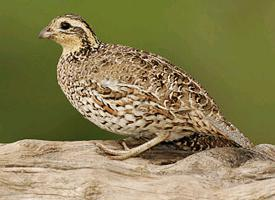
Váhy a míry
| Výška v kohoutku | od 24 do 28 cm |
|---|
Popis zvířete
The California quail, scientifically known as Callipepla californica, is a highly recognizable and cherished bird, emblematic of the western United States, particularly California, where it holds the esteemed title of the state bird. This species of quail is celebrated not only for its distinctive appearance but also for its social behavior and adaptability to its environment.Characterized by a plump body silhouette, the California quail is adorned with a rich gray and brown plumage that seamlessly blends into the chaparral, woodland, and suburban habitats it frequents. One of the most striking features of this bird is the forward-drooping plume on its head, which is made up of six feathers and can be seen in both males and females, though it is more pronounced in males. The male California quail boasts a vivid marking of black and white on its neck, which sharply contrasts with its brown body, while the female presents a more subdued coloration overall, aiding in camouflage.
Measuring about 9 to 11 inches in length and weighing between 140 to 190 grams, these birds are relatively small, yet their presence is anything but inconspicuous. Their calls, particularly the male's famous three-syllable “Chi-ca-go” call, fill their habitats with a unique soundtrack, especially during the breeding season. This call not only serves as a territorial claim but also helps in rallying the group together.
California quails are highly sociable birds, often seen foraging in groups known as coveys that can number in the dozens. These groups are a mix of families and individuals, banding together for protection against predators. Their diet is omnivorous, consisting of seeds, leaves, and occasional insects, which they forage for primarily on the ground.
Breeding season, which typically spans from spring through early summer, sees the construction of a shallow nest on the ground, concealed by vegetation. The female lays an average of 12 to 14 eggs, which she incubates for about three weeks. Once hatched, the precocial chicks are mobile and covered in down, ready to follow their parents and learn the intricacies of survival in their habitat.
The California quail's adaptability to various habitats, including those altered by human activity, has allowed it to thrive in many areas. However, like many wildlife species, it faces threats from habitat loss, predation, and environmental changes. Conservation efforts focus on habitat preservation and management to ensure the sustainability of this species, which plays a significant role in the biodiversity of its native regions.
In conclusion, the California quail, with its distinctive appearance, intriguing behaviors, and resilience, is a fascinating subject of study and an enduring symbol of the natural beauty of California and the western United States. Its presence enriches the ecosystems it inhabits, making it a cherished species among bird enthusiasts and conservationists alike.
Podobná zvířata
Nové fotografie zvířat
Top 10 zvířat
- Dolphin gull (Leucophaeus scoresbii)
- Stone loach (Barbatula barbatula)
- Diana monkey (Cercopithecus diana)
- Japanese macaque (Macaca fuscata)
- Greek tortoise (Testudo graeca)
- Galápagos tortoise (Geochelone nigra complex)
- Moustached guenon (Cercopithecus cephus)
- Russian tortoise (Testudo horsfieldii)
- Galápagos penguin (Spheniscus mendiculus)
- Common flying dragon (Draco volans)
